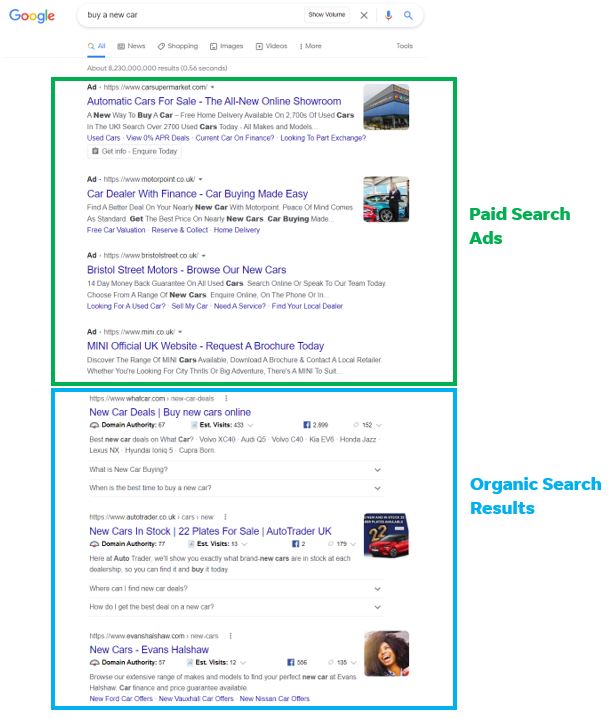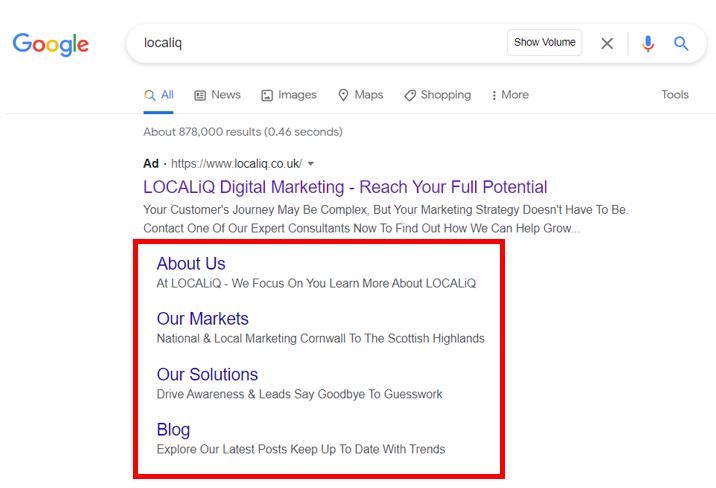Do you want to increase the visibility of your website? Paid search ads are a cost-effective way to promote your business and connect with your target audience. In this blog, we will cover the benefits of paid search with tips and examples to get you started.
In this guide to paid search we will cover:
• What is paid search?
• Paid search vs organic search.
• Benefits of paid search advertising.
• How paid search advertising works.
• Types of paid search ads.
• 8 steps to launch and manage your paid search marketing campaign
What is paid search?
Paid search is a form of digital marketing where search engines, such as Google, permit advertisers to place adverts directly on their search engine results page (SERP).
After you search for something on Google you arrive at the SERP, which is a page full of listings related to your search query. The SERP presents both organic results and paid results, although paid ads are usually displayed higher up on the page.
Paid search vs organic search
The easiest way to distinguish between paid and organic search results is by looking for the little word ‘Ad’ before the listing. This signifies that a business has paid to have their webpage displayed at the top of the SERP.
Example of SERP with paid ads located at the top of the list:

Google is the search engine market leader, with an 86.19% market share of desktop searches and 94.88% of the mobile search market share. You should take this into consideration when developing your paid search strategy. This isn’t to say that you should disregard other search engines, but you should prioritise Google as this is where most of your target audience will be.
Benefits of paid search advertising
There are many benefits associated with paid search advertising:
- Allows for targeted search results.
- Improves brand awareness and recognition.
- Delivers instant and measurable results.
- Produces an impressive return on investment (ROI) – most businesses earn an average ROI of $8 for every $1 spent (which works out about £6.55 for every £0.820 spent).
- Generates qualified leads and interested prospects.
- Budget-friendly.
The greatest benefit of paid search is to guarantee your website listing appearing at the top of the SERP. This helps to drive relevant traffic to your website, giving you an advantage over your competitors. Paid ads are also extremely time efficient; they can be set up in under an hour and your listing will immediately be displayed in the sponsored results.
Research indicates that many searchers are unable to tell the difference between paid and organic search results, suggesting that there is no difference in a searcher’s willingness to trust organic search results over paid results.
How paid search advertising works
Paid search works on a Pay-Per-Click (PPC) model, making it a measurable and controllable marketing channel in comparison to more traditional forms of advertising. PPC enables advertisers to bid on keywords to place ads on advertisement platforms. The highest bidder then pays the host of the platform when their ad is clicked, this is known as Cost-Per-Click (CPC).
Whenever there is a vacancy for an ad on SERP, an auction takes place for the related keyword. The CPC is determined by the competitiveness of your keywords, maximum bids and your quality scores. The ad that wins the auction then immediately appears on the SERP.
The purpose of a PPC campaign is to attract qualified users to your website and get them to take an action (e.g., make a purchase, apply for a course). Click-through-rate (CTR) is the first step to improve your ad’s relevancy and generate desired actions from users. CTR is the amount of people who click on the ad versus the amount of impressions the ad makes.
For instance, if your PPC ad had 100 impressions and one click, that’s a 1% CTR.
In most PPC platforms, your CTR helps determine both your ad rank and your cost per click. The higher your CTR in Google Ads, the better your ranking and the lower your costs.
– A high CTR indicates that users are finding your ad to be highly relevant.
– A low CTR indicated that users are finding your ad to be less relevant.
So, what is a good click-through rate for Google ads? It is highly dependent on your industry, business type, goals and other factors. However, the average click-through rate on Google Ads paid search ads is about 2%.
You can use this free benchmarking tool to see if your current Google Ads click-through rate is higher or lower than average in your industry.
Types of paid search ads
Search ads are designed to appear when the consumer is already searching for an answer or product. Therefore, advertising through paid search platforms creates opportunities for your business to be easily found and seen online. Nevertheless, these platforms are very diverse with many different ad formats and targeting options. Here are some paid search ad variables that your business should consider.
1. Traditional PPC text ads
These are the most common type of ads which show up in the SERP above organic listings. Text ads are simple ads, where you decide the search term or keyword that will trigger them and simply write your ad as you’d like it to appear. These work on a ‘bid’ system, the higher you would like to appear in the SERPs the higher the CPC.
Example of a text ad:

When used strategically, PPC campaigns are an excellent way to boost your visibility online, test new keywords, expand into new regions, and remarket to existing leads.
The first thing you will need to do before creating PPC ad campaigns is to set up your Google Ads account.
Learn how to create a Google Adwords text ad.
2. Local services ads
Local services ads are sponsored listings for services in your region that connect you to local customers searching for the services you offer. Unlike text ads, local service ads function on a cost-per-lead basis, with a lead counting as a phone call, booking, form or message made directly through the ad.
An example of Google search “Restaurants in London”. Businesses running local services ads appear at the top of the search results.

When researching online, many searches will be looking for products and services locally accessible to them. Geo-targeting is a way for you to target consumers in specific locations and adapt each ad’s messaging appropriate to their locality and behaviour.
Geotargeting is one of the most efficient and cost-effective ways of getting your business to rank highly in local searches. According to research, four in five people want to see local ads when they’re searching for goods or services online, making geotargeting a win-win. Not only do local ads save you money, but they also give users what they want, which makes your business all the more appealing!
Learn how to set up location targeting in Google Ads.
Get started setting up your local service ads.
3. Sitelinks to landing pages in PPC
Optimising your landing pages and creating effective PPC campaigns helps you maximise your ROI and reach prospects who are more likely to discover you through search engines.
Sitelinks provide advertisers with the ability to promote additional links to their website using one PPC ad. Using sitelinks in your PPC listing lets interested prospects preview key points on your landing page so they can quickly navigate to the section they’re looking for.
Example of sitelinks to instantly attract viewers to different parts of a website:

Google Ads Sitelinks: How to Use Google Ads Sitelinks Extensions
4. Remarketing through PPC
Remarketing is another useful advertising feature which involves placing your ads in front of potential leads who have previously interacted with your business online. Since users have already shown some form of interest in your business, remarketing is often very profitable.
Remarketing allows you to keep top of mind and ensure that prospects are not lost after leaving your website. In addition to attracting potential clients, remarketing ads increase brand awareness for existing customers.
Remarketing is more challenging to set up than the standard PPC and display ads, but once it is done you can have your business follow your customers and leads around the web to keep reminding them about the benefits of your products or services.
8 steps to launch and manage your paid search marketing campaign
1. Set a goal for your PPC campaign
All campaigns need a SMART goal so that you can actively track and monitor their performance and adjust accordingly. You need a clear objective, such as generating leads, increasing website traffic or boosting conversions. Remember that these goals need to be specific and timely.
Example of a SMART goal:
“Within 5 months, I would like to see a 10% increase in traffic to our website by spending $1,000 per month on Google paid ads.”
2. Analyse keywords
Once you’ve determined your goal, type of ad campaign, location and other details, it’s time to select your keywords. Since you are paying for each click on your ads, it’s imperative to only bid on keywords that are specific and relevant to your business.
There are many kinds of keywords that you can use in your PPC advertising strategy, however, keywords don’t come cheap. Check out the 20 most expensive keywords in Google Ads.
If you are paying high CPC you want to make sure that it is worth it. An effective keyword tool can help you select keywords likely to drive sales or conversions that aren’t overly expensive.
Here are keyword types which should play a part in your PPC campaign strategy:
- Long-tail keywords are several words long, highly specific, unique phrases. These phrases are often very low-cost and have less keyword competition. However, long-tail keywords often have low search volume and limited impressions too.
- Negative Keywords are an efficient way to save money on your PPC campaign, they ensure your ads don’t match irrelevant search queries. This helps you focus only on the keywords that matter to your customers.
- Branded Keywords are queries that includes your website’s brand name or variations of it and is unique to your domain. Branded terms are useful to raise brand awareness and reach users who already know about your business, as well as to target people searching for specific products making your website visible to your prospects. Additionally this type of keyword tends to have very low costs and very high quality scores thereby yields excellent results in terms of click-through rate and conversion rate.
Example of branded keywords:
“Apple iphone”, “Cadbury’s chocolate”, “Nike trainers”.
Bidding on your branded keywords ensures you are covering key search terms related to your business and protecting your brand against competitors. If your competitors are bidding on your brand, then you should definitely be doing it to preserve top rankings and search engine real estate.
Branded keywords typically have a lower CPC compared with other keywords. However, you don’t want to overdo it and bid on all terms containing your brands name. Many of your existing customers will be searching on Google, simply to visit your website. These visitors could potentially be clicking your PPC ads simply to get to the website, thereby cannibalising your organic traffic and wasting your PPC ad budget.
- Non-Branded Keywords
Searching trends are moving toward more non-branded terms which compromise of general terms and phrases related to your products and services. For instance, if you have a gardening business you could use non-branded keywords such as, ‘landscaping’, ‘plants’, grass cutting’ etc.
Studies demonstrate that users prefer an even split between non-branded keywords and branded keywords to locate the information they want, typically starting with general phrases i.e., “Women’s trainers” and then getting more specific i.e., “Adidas original women’s trainers”.
- Competitive keywords
It’s a good idea to allocate some budget toward bidding on competitive keywords. This allows you to get your business and in front of people who are searching for your competitors’ products or services.
It’s time to find out which keywords are burning your budget. Get a free account audit with our Google Ads Performance Grader today!
3. Choose your match type
Once you have selected your keywords, you need to choose a keyword match type, which tells Google how aggressively or restrictively you want to match your advertisement to user search queries.
To put it simply, there are 3 different keyword match types:
1. Broad match is the default match type and the one that reaches the largest audience. When using broad match type, your ad is eligible to appear whenever a user’s search query includes any word in your key phrase, in any order. This includes searches that are related to your keyword phrase. An example being if you have bid on “sports nutrition” your ad will still be considered if the search query is “nutrition for sports and exercise”.
However, it’s important to be careful with broad match types because although they are terrific for driving lots of clicks, you must keep an eye on search query reports to ensure that you’re not paying for irrelevant traffic that doesn’t convert. Use broad match if the goal of your PPC campaign is to bring in the maximum amount of traffic to your landing page.
2. Phrase match is the middleman between broad match and exact match, offering some of the versatility of broad match, but with a higher level of control. Your ad will appear if the users search query includes the keyword phrase, even if there are words before or after it. For instance, if user searches “the best vitamin supplements for immune system” and you have bid on “vitamin supplements” your ad would be considered.
3. Exact match is the most specific and limiting of the keyword match types. With this match type, your paid search ad will only appear if the users search query exactly matches your keyword phrase. For example, if you bid on “protein powder” your Google ad will only be displayed if the search query is “protein powder”.
Google Ads Match Types: What Are Keyword Match Types?
4. Create your ads
Now you have established your goals, keywords and their match types, you are ready to begin creating your paid search ads. Here are some guidelines to keep in mind when writing your ads.
Text ads have four primary elements:
- Headline 1 allows for up to 30 characters.
- Headline 2 allows for up to 30 characters.
- Display URL
- Description allows for up to 80 characters.

Text ads cannot contain:
- All capital letters (e.g. MARKETING)
- Symbols to draw attention to your ads (e.g. ***Marketing***)
- Additional spacing (e.g. M a r k e t i n g)
- Exclamation marks in the headlines.
5. Focus on the language of your PPC copy
Once you understand what makes people click on an ad, it’s easier to generate conversions. Relevance alone is not enough for users to click on an ad, it must also offer a reason why they should be interested enough to click on it.
You text ad copy needs to be:
– clear
– descriptive
– relevant
– persuasive
Best practice for writing PPC text ads:
- Target around 3-5 specific keywords that are relevant to your organisation and industry sector.
- Implementing a keyword tool to help you identify the best keywords for your business.
- Use descriptive words in your PPC ads to truly depict your business and set you apart from your competitors e.g., ‘innovative’ ‘modern’ ‘adaptable’.
- Include specific call-to-actions. For example, if you want your customers to download your content include ‘Download now’ CTA in your ad.
- Think about your user and the information they are looking for, and incorporate that into your text ad. What differentiates you from your competition? Do you offer any specialist products or services?
6. Use Ad Groups
Ad Groups are a vital part of PPC marketing. They include all ads that share similar targets and are focused on a set of keywords in an ad campaign. When used correctly ad groups can drive traffic and leads to your site at a lower cost, resulting in more conversions.

Ad Groups are basically a structural component within your ad campaigns, which enable you to organise your PPC account into a meaningful hierarchy. You want to use ad groups to organise your ads by a common theme. For instance, you can create ad groups based off your campaign objective, campaign audience or the products and services you offer. When creating ad groups for your business think about the different products or services you offer, and which audience you are trying to target.
7. Optimise paid ads for mobile
According to Statista, mobile web traffic has consistently accounted for about half of all global web traffic since the beginning of 2017. However, mobile devices tend to have different user behaviour and search intent than desktop and tablet devices. So, you may be ranking well on desktop but not even appear on the first page of results on mobile. This means you must consider optimising your paid search ads for mobile use. Moreover, not doing so will actually be detrimental to your marketing efforts!
SEMRush found that, only 13% of websites are able to retain the same position for a particular search across all devices. To protect your mobile rankings, you need to regularly check that your website is optimized for mobile, and keep an eye on mobile rankings rather than simply keeping tracking of desktop rankings.
Top Tip: Keep an eye on how your site is performing on mobile by regularly reviewing your Google Analytics dashboard and frequently running a mobile site speed test.
8. Be strategic with budget
There are many factors to consider when it comes to your budget. A lot of these factors will be determined by your industry sector environment and competitors. For instance, businesses in London are likely to have a higher CPC than those in Dorchester because of the competition around the location word.
Find out which keywords are burning your budget. Get a free account audit with our Google Ads Performance Grader today!
How much should you budget for PPC?
LOCALiQ’s client typically begin by investing £1,000 for their PPC budget.
– Implement a bidding strategy
As previously mentioned, PPC campaigns can get very expensive if they aren’t set up right. Therefore, you need to be strategic with your budget. To minimise the risk of wasting your budget, you can set a maximum bid cap. You set this bid as the maximum amount to tell Google how much you’re willing to pay when someone clicks on your ad.
There are various other bidding strategies that you can use to control the spending of your budget. Look at the pros and cons of each bidding strategy and select the most appropriate for each campaign.
– Monitor your quality score
Quality scores are Google’s rating of the quality and relevance of both your keywords and PPC ads. These scores have a vast influence over the cost and effectiveness of your paid search campaigns because they are used to determine your CPC and multiplied by your maximum bid to determine your ad rank in the ad auction process.
Your Quality Score depends on multiple factors, including:
– Your click-through rate (CTR).
– The relevance of each keyword to its ad group.
– Landing page quality and relevance.
– The relevance of your ad text.
– Your historical Google Ads account performance.
If you’re interested in running paid search advertising, but don’t know where to start then get in touch. Talk to one of our experts today!






